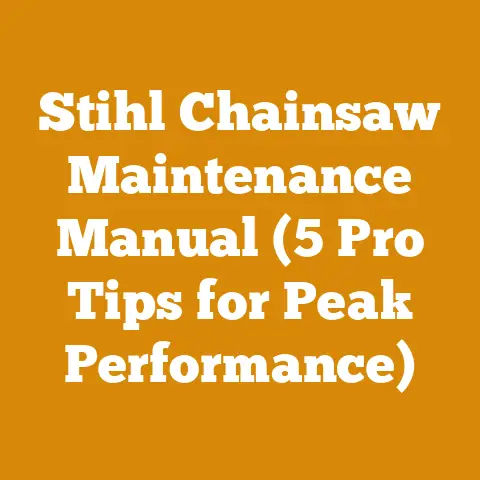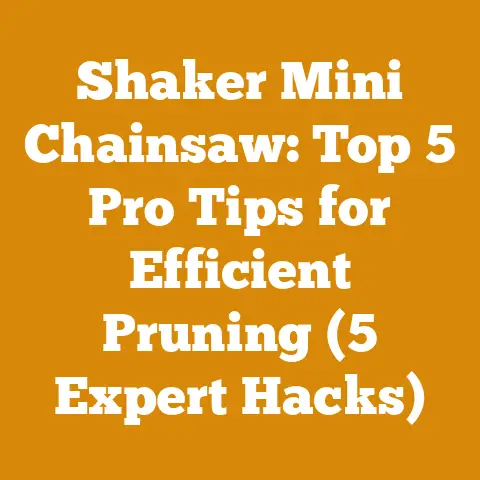Grinding Roots Safely (5 Expert Tips for Arborists)
Have you ever driven past a house undergoing renovations and wondered what hidden challenges lie beneath the surface?
I have, countless times.
And often, those challenges aren’t just structural; they’re rooted – quite literally – in the ground.
I’m talking about tree roots.
I’ve seen it all, from homeowners tripping over stray roots in their gardens to construction crews battling a tangled mess under a new patio.
Removing a tree is often just the beginning.
The real challenge is what’s left behind: a stubborn, sprawling root system that can wreak havoc on landscaping, foundations, and future construction projects.
That’s where root grinding comes in.
As an arborist with over 15 years of experience, I’ve tackled my fair share of root grinding jobs.
I’ve learned a thing or two (sometimes the hard way) about doing it safely and effectively.
I’ve seen firsthand the damage that can occur from a poorly executed grinding job, and I’ve also witnessed the satisfaction of a smooth, clean finish that allows for a fresh start.
This article is born from those experiences.
It’s a compilation of the best practices I’ve developed, the hard-won lessons I’ve learned, and the expert tips I rely on to ensure a safe and successful root grinding operation every time.
Whether you’re a seasoned arborist or a homeowner tackling a DIY project, this guide will equip you with the knowledge and techniques you need to grind roots safely and efficiently.
Key Takeaways:
- Safety First: Understand the potential hazards and implement proper safety measures before you even start the grinder.
- Preparation is Key: Thoroughly assess the site, identify utilities, and clear the area for optimal grinding.
- Technique Matters: Learn the proper grinding techniques to achieve the desired results while minimizing risk.
- Equipment Maintenance: Keep your grinder in top condition to ensure safe and efficient operation.
- Post-Grinding Considerations: Properly dispose of the grindings and address any potential soil issues.
Let’s dive in and get to the root of the matter!
Grinding Roots Safely: 5 Expert Tips for Arborists
1. Prioritizing Safety: A Foundation for Safe Root Grinding
Safety isn’t just a checklist; it’s a mindset.
Before you even think about firing up that grinder, you need to understand the potential risks and take proactive steps to mitigate them.
I’ve learned this lesson the hard way, witnessing near misses and even minor injuries that could have been avoided with better preparation.
Understanding the Risks
Root grinding, while seemingly straightforward, presents a multitude of hazards.
Let’s break down the most common:
- Flying Debris: This is the most obvious risk.
The high-speed rotation of the grinding wheel can send wood chips, rocks, and other debris flying at dangerous velocities.
Think of it like a miniature, uncontrolled wood chipper. - Kickback: Similar to chainsaw kickback, root grinders can experience kickback if the wheel encounters an obstruction or binds in the soil.
This can cause the machine to jerk violently, potentially throwing you off balance or causing injury. - Underground Utilities: Hitting a buried utility line (gas, electric, water, sewer) can have catastrophic consequences, ranging from power outages and flooding to explosions and electrocution.
This is not an exaggeration. - Noise Exposure: Root grinders are loud.
Prolonged exposure to high noise levels can lead to hearing damage. - Dust Inhalation: Grinding dry roots creates a significant amount of dust, which can irritate the respiratory system and potentially lead to long-term health problems.
- Machine Malfunction: Like any piece of machinery, root grinders can malfunction.
A broken wheel, a faulty engine, or a loose bolt can all lead to accidents.
Implementing Safety Measures
Now that we understand the risks, let’s talk about how to minimize them.
Here’s my tried-and-true checklist:
- Personal Protective Equipment (PPE): This is non-negotiable.
At a minimum, you need:- Safety Glasses: Protect your eyes from flying debris.
Don’t skimp on these.
Get a pair that fits well and provides good coverage. - Hearing Protection: Earplugs or earmuffs are essential to protect your hearing.
I prefer earmuffs because they’re more comfortable for extended use. - Gloves: Protect your hands from cuts, abrasions, and vibration.
I recommend heavy-duty work gloves. - Steel-Toed Boots: Protect your feet from falling objects and sharp debris.
- Long Pants and Long-Sleeved Shirt: Provide a barrier against flying debris and protect your skin from scratches and abrasions.
- Face Shield (Optional but Recommended): Provides an extra layer of protection for your face.
- Safety Glasses: Protect your eyes from flying debris.
- Site Assessment and Preparation:
- Call Before You Dig: This is the single most important step.
Contact your local “Call Before You Dig” service (usually 811 in the US) to have underground utilities marked.
This is a free service and can save your life. - Clear the Area: Remove any rocks, debris, or other obstructions from the grinding area.
This will reduce the risk of flying debris and prevent damage to the grinder. - Establish a Safety Zone: Create a clear zone around the grinding area to keep bystanders at a safe distance.
I typically use caution tape to delineate the zone.
- Call Before You Dig: This is the single most important step.
- Machine Inspection and Maintenance:
- Pre-Operation Check: Before each use, inspect the grinder for any signs of damage or wear.
Check the teeth, the engine, the hydraulic lines, and all other components. - Regular Maintenance: Follow the manufacturer’s recommended maintenance schedule.
This includes changing the oil, lubricating moving parts, and sharpening the teeth.
- Pre-Operation Check: Before each use, inspect the grinder for any signs of damage or wear.
- Safe Operating Procedures:
- Read the Manual: Sounds obvious, but many people skip this crucial step.
The manual contains important information about the grinder’s operation and safety features. - Maintain a Firm Grip: Keep both hands on the grinder at all times.
- Use Proper Body Positioning: Position yourself so that you have good balance and can control the grinder effectively.
- Avoid Overreaching: Don’t try to grind roots that are too far away.
Move the grinder closer to the root. - Be Aware of Your Surroundings: Pay attention to what’s happening around you.
Watch out for bystanders, animals, and other potential hazards. - Take Breaks: Root grinding can be physically demanding.
Take frequent breaks to avoid fatigue.
- Read the Manual: Sounds obvious, but many people skip this crucial step.
- Emergency Plan:
- First Aid Kit: Keep a well-stocked first aid kit on hand.
- Communication: Have a way to communicate with others in case of an emergency (e.g., a cell phone or two-way radio).
- Emergency Contact Information: Keep a list of emergency contact numbers readily available.
Data Point: According to the Tree Care Industry Association (TCIA), the most common injuries associated with tree care operations are cuts, lacerations, and contusions, often caused by flying debris or improper use of equipment.
Wearing appropriate PPE can significantly reduce the risk of these injuries.
2. Site Assessment and Preparation: Setting the Stage for Success
Once you’ve prioritized safety, the next step is to thoroughly assess the site and prepare it for grinding.
This involves more than just showing up with the grinder and firing it up.
A well-prepared site will not only make the grinding process safer and more efficient but also ensure a better final result.
Identifying Underground Utilities: The Absolute Must-Do
I cannot stress this enough: Call Before You Dig! It’s not just a slogan; it’s a life-saving practice.
Contact your local “Call Before You Dig” service at least 48 hours before you plan to start grinding.
They will send representatives to mark the location of underground utilities, such as gas lines, electric lines, water lines, and sewer lines.
Why is this so important?
- Safety: Hitting a gas line can cause an explosion.
Hitting an electric line can cause electrocution.
Hitting a water line can cause flooding. - Cost: Repairing damaged utility lines can be incredibly expensive.
You’ll be responsible for the cost of repairs, and you may also face fines. - Inconvenience: Damaging a utility line can cause disruptions to service for you and your neighbors.
How to Call Before You Dig:
- Dial 811 in the United States. In other countries, look up the equivalent service.
- Provide the location of the work site.
- Describe the type of work you’ll be doing (root grinding).
- Wait for the utilities to be marked.
Once the utilities have been marked, carefully avoid them while grinding.
If you’re unsure about the location of a utility line, err on the side of caution and hand-dig around the area.
Personal Story: I once worked on a site where the homeowner insisted that there were no underground utilities.
I convinced him to call “Call Before You Dig” anyway.
Turns out, there was a gas line running directly through the area where we were planning to grind.
We could have easily caused a major explosion if we hadn’t called.
Assessing the Root System: Understanding the Scope of the Job
Before you start grinding, take a good look at the root system.
Consider the following:
- Size and Extent: How large are the roots?
How far do they extend?
This will help you determine the amount of time and effort required to grind them. - Type of Wood: Some types of wood are harder to grind than others.
Knowing the type of wood will help you choose the right grinding technique and adjust your machine settings. - Soil Conditions: Is the soil loose and sandy, or is it compacted and rocky?
Rocky soil can damage the grinding wheel and slow down the process. - Obstructions: Are there any rocks, debris, or other obstructions in the grinding area?
Remove these before you start grinding. - Proximity to Structures: How close are the roots to buildings, fences, or other structures?
You’ll need to be extra careful when grinding near these structures to avoid damaging them.
Clearing the Area: Creating a Safe and Efficient Workspace
Once you’ve assessed the root system, it’s time to clear the area.
This involves removing any obstacles that could interfere with the grinding process or pose a safety hazard.
- Remove Rocks and Debris: Pick up any rocks, branches, or other debris from the grinding area.
This will prevent them from being thrown by the grinder and potentially causing injury or damage. - Cut Away Overhanging Branches: If there are any overhanging branches, cut them away to provide a clear workspace.
- Clear Vegetation: Remove any grass, weeds, or other vegetation from the grinding area.
This will make it easier to see the roots and prevent the grinder from getting tangled in the vegetation. - Protect Nearby Structures: If you’re grinding near buildings, fences, or other structures, protect them with tarps or plywood to prevent them from being damaged by flying debris.
Data Point: A study by the International Society of Arboriculture (ISA) found that proper site preparation can reduce the time required for tree removal and root grinding by up to 20%.
3. Mastering the Grinding Technique: Precision and Control
Grinding roots isn’t just about brute force; it’s about precision and control.
The right technique can make all the difference between a smooth, efficient job and a frustrating, potentially dangerous one.
Over the years, I’ve refined my technique based on countless hours of experience and observation.
Here are some of the key principles I follow:
Choosing the Right Grinding Wheel
The type of grinding wheel you use can significantly impact the efficiency and effectiveness of your work.
There are two main types of grinding wheels:
- Carbide-Tipped Wheels: These wheels are more expensive than steel wheels, but they are also more durable and can last much longer.
Carbide-tipped wheels are ideal for grinding hard woods and roots that are embedded in rocky soil. - Steel Wheels: These wheels are less expensive than carbide-tipped wheels, but they are also less durable.
Steel wheels are best suited for grinding soft woods and roots that are in relatively clean soil.
When choosing a grinding wheel, consider the following factors:
- Type of Wood: Hard woods require a more durable wheel than soft woods.
- Soil Conditions: Rocky soil can damage a less durable wheel.
- Frequency of Use: If you’ll be using the grinder frequently, invest in a more durable wheel.
- Budget: Carbide-tipped wheels are more expensive than steel wheels.
Starting the Grind: A Gradual Approach
Don’t just plunge the grinding wheel into the root.
Start slowly and gradually increase the pressure.
This will give you more control over the grinder and prevent kickback.
- Position the Grinder: Position the grinder so that the grinding wheel is just touching the root.
- Start the Engine: Start the engine and let it warm up for a few minutes.
- Engage the Wheel: Slowly engage the grinding wheel.
- Apply Gentle Pressure: Apply gentle pressure to the root.
- Increase Pressure Gradually: As the wheel starts to grind, gradually increase the pressure.
The Sweeping Motion: Achieving a Uniform Grind
The key to a smooth, uniform grind is to use a sweeping motion.
Move the grinder back and forth across the root, overlapping each pass slightly.
This will prevent you from leaving any ridges or uneven spots.
- Maintain a Consistent Speed: Maintain a consistent speed as you sweep the grinder back and forth.
- Overlap Each Pass: Overlap each pass by about 50%.
- Avoid Digging Too Deep: Don’t try to grind too deep in one pass.
It’s better to make multiple shallow passes than one deep pass.
Grinding at Different Angles: Reaching Difficult Areas
Sometimes, you’ll need to grind roots that are in difficult-to-reach areas, such as near buildings or fences.
In these cases, you may need to adjust the angle of the grinding wheel.
- Grinding at a 45-Degree Angle: Grinding at a 45-degree angle can help you reach roots that are close to walls or fences.
- Grinding at a 90-Degree Angle: Grinding at a 90-degree angle can help you grind roots that are growing straight up.
Dealing with Obstructions: Patience and Persistence
You’re bound to encounter obstructions while grinding roots, such as rocks, metal, or concrete.
When you encounter an obstruction, stop grinding and remove it.
- Rocks: Remove rocks by hand or with a shovel.
- Metal: Remove metal with a metal detector and a pair of pliers.
- Concrete: Break up concrete with a sledgehammer and chisel.
Knowing When to Stop: Avoiding Over-Grinding
It’s important to know when to stop grinding.
Over-grinding can damage the soil and make it difficult to plant new trees or shrubs.
- Grind to the Desired Depth: Grind the roots to the desired depth.
Typically, you’ll want to grind the roots to a depth of 6-12 inches below the surface. - Avoid Over-Grinding the Soil: Avoid grinding the soil more than necessary.
This can damage the soil structure and make it difficult to plant new vegetation.
Case Study: I once worked on a project where the client wanted us to grind the roots of a large oak tree.
The roots were very extensive, and we had to be careful not to damage the surrounding landscape.
We used a combination of techniques, including grinding at different angles and removing obstructions, to successfully grind the roots without causing any damage.
4. Equipment Maintenance: Ensuring Longevity and Performance
A well-maintained root grinder is a safe and efficient root grinder.
Neglecting maintenance can lead to breakdowns, reduced performance, and even dangerous situations.
I treat my equipment with respect because I know it directly impacts my safety and livelihood.
Regular Inspection: Catching Problems Early
Before each use, take a few minutes to inspect your root grinder for any signs of damage or wear.
This simple step can help you catch problems early before they become major issues.
- Check the Teeth: Inspect the teeth for any cracks, chips, or wear.
Replace any damaged or worn teeth immediately. - Check the Engine: Check the engine for any leaks or unusual noises.
Make sure the oil level is correct. - Check the Hydraulic Lines: Check the hydraulic lines for any leaks or damage.
- Check the Belts and Pulleys: Check the belts and pulleys for any wear or damage.
- Check the Frame: Check the frame for any cracks or damage.
Sharpening the Teeth: Maintaining Cutting Efficiency
Sharp teeth are essential for efficient root grinding.
Dull teeth will slow down the process and put unnecessary strain on the engine.
- Use a Grinding Wheel: Use a grinding wheel to sharpen the teeth.
- Follow the Manufacturer’s Instructions: Follow the manufacturer’s instructions for sharpening the teeth.
- Wear Safety Glasses: Wear safety glasses to protect your eyes from flying debris.
Lubrication: Keeping Moving Parts Moving
Proper lubrication is essential for keeping the moving parts of your root grinder running smoothly.
- Grease Fittings: Grease the grease fittings regularly.
- Oil Change: Change the oil according to the manufacturer’s recommendations.
- Lubricate Chains and Cables: Lubricate chains and cables with a suitable lubricant.
Cleaning: Removing Debris and Protecting Components
Keeping your root grinder clean will help prevent corrosion and extend its lifespan.
- Remove Debris: Remove any debris from the grinder after each use.
- Wash the Grinder: Wash the grinder with soap and water.
- Dry the Grinder: Dry the grinder thoroughly.
- Apply a Protective Coating: Apply a protective coating to prevent corrosion.
Storage: Protecting Your Investment
Proper storage is essential for protecting your root grinder from the elements.
- Store in a Dry Place: Store the grinder in a dry place to prevent corrosion.
- Cover the Grinder: Cover the grinder with a tarp to protect it from the sun and rain.
- Drain the Fuel: Drain the fuel from the engine before storing the grinder for an extended period.
Data Point: A study by a leading equipment manufacturer found that regular maintenance can extend the lifespan of a root grinder by up to 30%.
5. Post-Grinding Considerations: Completing the Job
Once you’ve finished grinding the roots, the job isn’t quite done.
You need to properly dispose of the grindings and address any potential soil issues.
This final step is crucial for ensuring a clean and safe site and promoting healthy regrowth.
Disposing of Grindings: Environmentally Responsible Practices
The wood chips and soil mixture created during root grinding can be a valuable resource if handled properly.
Here are some environmentally responsible ways to dispose of or reuse the grindings:
- Mulching: The grindings can be used as mulch around trees and shrubs.
Mulch helps to retain moisture in the soil, suppress weeds, and regulate soil temperature.
However, be cautious about using grindings from diseased trees as mulch, as this could spread the disease. - Composting: The grindings can be added to a compost pile.
Composting is a natural process that breaks down organic matter into a nutrient-rich soil amendment. - Landfill Disposal: If you can’t reuse the grindings, you can dispose of them at a landfill.
However, this should be a last resort, as it takes up valuable landfill space. - Soil Amendment: Depending on the soil conditions, the grindings can be mixed back into the soil as a soil amendment.
This can help to improve the soil’s structure and fertility.
Addressing Soil Issues: Promoting Healthy Regrowth
Root grinding can disrupt the soil structure and deplete nutrients.
It’s important to address these issues to promote healthy regrowth.
- Soil Testing: Conduct a soil test to determine the nutrient levels and pH of the soil.
This will help you determine what amendments are needed. - Soil Amendments: Add soil amendments, such as compost, manure, or fertilizer, to improve the soil’s fertility.
- Compaction Relief: If the soil is compacted, aerate it to improve drainage and aeration.
- Erosion Control: If the site is prone to erosion, take steps to control erosion, such as planting ground cover or installing erosion control blankets.
- Planting New Vegetation: Once the soil has been amended, you can plant new trees, shrubs, or grass.
Choose plants that are well-suited to the soil conditions and climate.
Site Restoration: Leaving a Positive Impression
Finally, take the time to restore the site to its original condition.
This will leave a positive impression on your clients and help to protect the environment.
- Rake the Area: Rake the area to remove any remaining debris.
- Fill in Holes: Fill in any holes with topsoil.
- Seed or Sod: Seed or sod the area with grass.
- Water Thoroughly: Water the area thoroughly to help the new vegetation establish itself.
Expert Quote: “The key to successful site restoration is to understand the soil conditions and choose the right plants and amendments.
A little extra effort in this stage can make a big difference in the long-term health and beauty of the landscape.” – Dr. Emily Carter, Soil Scientist
Conclusion: Rooted in Safety and Expertise
Grinding roots safely and effectively requires a combination of knowledge, skill, and preparation.
By following the expert tips outlined in this article, you can minimize the risks associated with root grinding and achieve professional results.
Remember, safety should always be your top priority.
Take the time to assess the site, prepare the area, and use the proper techniques.
Maintain your equipment regularly and dispose of the grindings responsibly.
By following these guidelines, you can ensure a safe and successful root grinding operation every time.
Now that you’re armed with this knowledge, I encourage you to put it into practice.
Start with small projects and gradually work your way up to larger, more complex jobs.
With experience and dedication, you’ll become a master of root grinding and a valuable asset to your community.
Call to Action: Ready to take your root grinding skills to the next level?
Invest in quality safety gear and consider enrolling in a professional arborist training program.
Your safety and success are worth the investment!






